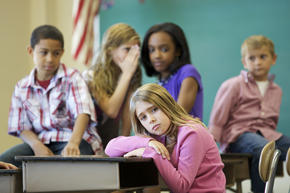
October is officially National Bullying Prevention Month. According to statistics on bullying, 2.7 million students reported being bullied in 2010 alone, and about 160,000 children miss school every day from fear of being bullied. For students who suffer from depression or low self-esteem, bullying can be a breaking point which, in extreme cases, can lead to suicide. It is important to help students develop fundamental strategies for dealing with their peers at a young age so that they are better able to handle conflict as they get older. What can we do to help our students recognize the dangers of bullying and teach them conflict resolution strategies?
T.L.C.
As a teacher, you can actively work to prevent bullying by incorporating role playing and other experiential activities into your classroom curriculum. One way to start is by introducing the acronym “TLC” to your students. Have them write down what each letter stands for: “T”- Take a step back, “L”- Listen before you speak, “C” – Chill out. You can explain to your students that the TLC technique is a useful way to look at a situation when they are faced with a conflict.
Role Playing
Getting your students involved in conflict resolution activities through role playing can help them figure out how to solve a problem in a positive and productive manner. With your class, create a list of possible conflicts that might arise on the playground or at home. Then, write a small script to go along with each problem. You can write the script, or you can have small groups make their own scripts. Then, have different students role play a scenario for the rest of the class. It is important to encourage a class discussion once you have gone through each mini-skit so that your students can digest what they experienced. Follow up with a homework assignment, such as a journal entry, in which they can express their feelings about the topic on paper, as some students might not feel comfortable sharing their thoughts aloud with the class.
Put Yourself in Their Shoes
A hands-on activity you can do with your students is the shoe project. Prior to the start of class, have a stack of construction paper cut into the shape of a shoe. Begin by asking your students to remember a time when they were at odds with someone and to recall how they handled the situation. Depending on the age, your students could write this experience on one side of the shoe paper. Then, tell them they are now going to put on the other person’s shoes, and have them write how they think the other person might have felt at the time. Once they are done, have each student stand up to share their experience and the theoretical experience of the other person. This activity helps students consider situations from a different perspective. There is always the chance that someone won’t have anything to write about, so be prepared with suggestions. For more conflict resolution activities for the classroom, check out the following lesson plans.
Conflict Resolution Lessons and Activities:
Bully Prevention
This powerful lesson for third and fourth grade students focuses on evaluating situations and brainstorming ways to prevent them. There is a worksheet that correlates with the lesson.
Conflict Management
In this lesson, students learn the “3 R’s” approach for dealing with bullying, as well as a lesson script with which they will apply the approach. There is also an art project included in this lesson.
Conflict is Inevitable, Bullying is Not
For this lesson, students have a chance to identify the differences between conflict and bullying. It also includes an activity for students to create their own skits about bullying.
Bullying Is Not Acceptable
In this experiential lesson, students learn to recognize the emotional impact bullying can have. They also learn to identify different types of bullying (physical and emotional) by working in groups to create a poster board.

